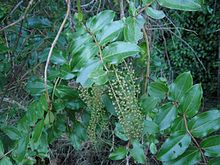Izatha mesoschista
| Izatha mesoschista | |
|---|---|

| |
| Scientific classification | |
| Domain: | Eukaryota |
| Kingdom: | Animalia |
| Phylum: | Arthropoda |
| Class: | Insecta |
| Order: | Lepidoptera |
| Family: | Oecophoridae |
| Genus: | Izatha |
| Species: | I. mesoschista
|
| Binomial name | |
| Izatha mesoschista Meyrick, 1931
| |
Izatha mesoschista is a moth of the family Oecophoridae. It is endemic to New Zealand.
Taxonomy
This species was described by Edward Meyrick in 1931[1] using seven specimens collected by George Hudson in Wellington during the months of December and January.[2] Hudson discussed and illustrated the species in his 1928 work The butterflies and moths of New Zealand under the name Izatha balanophora[3] but later corrected his taxonomic error in 1939.[4]
Description
The larva of this species has not been described.[5]
The adult moth has a wingspan of 15.5–21 mm for males and 17–25 mm for females.[5] Adults are on wing from October to February.[5]
The appearance of the adult moths of this species is variable and as a result it was originally confused with Izatha balanophora.[5] However it can be distinguished from this species as I. mesoschista has a bold black line in the middle of the disk on its forewings.[2] This line also assists in distinguishing I. mesoschista from Izatha epiphanes.[5] Other than using their collection location as a guide, it is difficult to distinguish between I. mesoschista and Izatha haumu.[6] I. haumu is found at the top of the North Island and I. mesochista is present south of this locality, over the rest of the North Island.[7] However a male I. mesoschista can be distinguished from both I. haumu and I. epiphanes by the species characteristic three pronged tip of its genitalia.[5]
Distribution
I. mesoschista is endemic to New Zealand.
Host plants

Specimens have been reared from Populus species, presumably from the dead wood, and also from pine logs.[5] Larvae of this species have also been extracted or reared from Coriaria arborea and Coprosma species.[7]
Trapping techniques
This species is readily attracted to light.[5]
References
- ^ Dugdale, J. S. (1988). "Lepidoptera - annotated catalogue, and keys to family-group taxa" (PDF). Fauna of New Zealand. 14: 1–123. Archived from the original (PDF) on 27 January 2019. Retrieved 27 April 2018.
- ^ a b Meyrick, Edward (1931). "New Species of New Zealand Lepidoptera". Transactions and Proceedings of the New Zealand Institute. 62: 92–97.
- ^ Hudson, George Vernon (1928). The butterflies and moths of New Zealand. Wellington: Ferguson & Osborn Ltd. p. 279. Archived from the original on 16 January 2018. Retrieved 27 April 2018.
- ^ Hudson, George Vernon (1939). A supplement to the butterflies and moths of New Zealand. Wellington: Ferguson & Osborn Ltd. p. 448. Archived from the original on 28 April 2018. Retrieved 27 April 2018.
- ^ a b c d e f g h i j Hoare, R. J. B. (2 September 2010). "Izatha (Insecta: Lepidoptera: Gelechioidea: Oecophoridae)" (PDF). Fauna of New Zealand. 65: 1–201.
- S2CID 83666096.
- ^ a b Bennik, Rebecca Marie (2014). Sexual conflict and genital evolution in moths (PDF) (Thesis). University of Auckland. Retrieved 28 April 2018.
- Wikidata Q45922947.
- ^ "Izatha mesoschista Meyrick, 1931". www.nzor.org.nz. Landcare Research New Zealand Ltd. Retrieved 27 April 2018.
